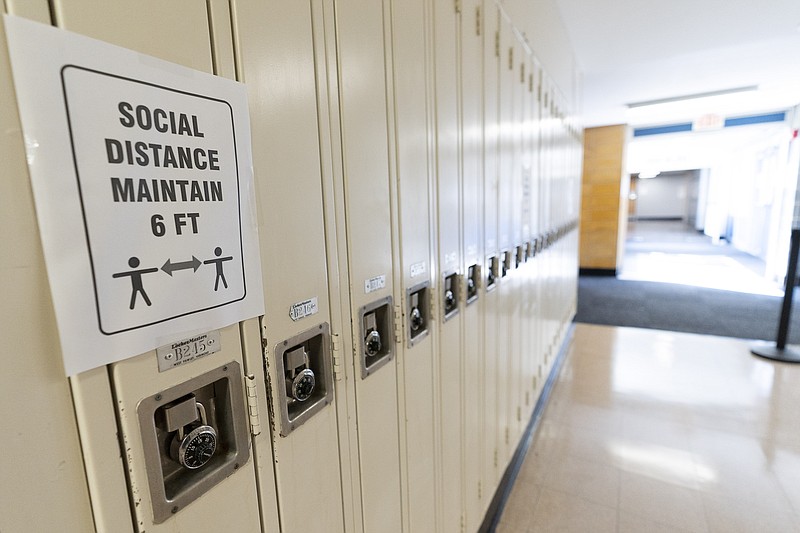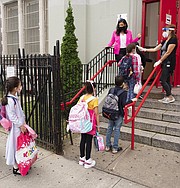After preying heavily on the elderly in the spring, the coronavirus is increasingly infecting American children and teens in a trend authorities say appears fueled by school reopenings and the resumption of sports, play dates and other activities.
Children of all ages now make up 10% of all U.S cases, up from 2% in April, the American Academy of Pediatrics reported Tuesday. The Centers for Disease Control and Prevention said Monday that the incidence of covid-19 in school-age children began rising in early September as many youngsters returned to their classrooms.
About two times more teens were infected than younger children, the CDC report said. Most infected children have mild cases; hospitalizations and death rates are much lower than in adults.
The CDC report said more than 277,000 children ages 5-17 were confirmed infected between March and Sept. 19, with an increase in September after a peak and a decline over the summer.
The agency acknowledged that may be an underestimate, in part because testing is most often done on people with symptoms, and children with the coronavirus often have none.
The CDC reported 51 deaths in school-age kids, most in them ages 12-17. Less than 2% of infected children were hospitalized, and youngsters who are Black, Hispanic or have underlying conditions fared worse than white children.
The findings add to other data showing that the pandemic is increasingly affecting younger age groups after initially hitting older Americans hard.
In a separate report Tuesday, the CDC said weekly covid-19 cases among people ages 18-22 increased 55% nationally. The increases were greatest in the Northeast and Midwest, and were not solely attributable to increased testing, the CDC said. About one-third of U.S. cases are in adults 50 and older, while one-quarter are in 18- to 29-year-olds.
The American Academy of Pediatrics research is based on reports from public health departments in 49 states, New York City, Washington, D.C., Puerto Rico and Guam. New York state doesn't provide data by age. Most states count children's cases up to age 19, though a few use different age ranges.
As of Sept. 24, the American Academy of Pediatrics counted nearly 625,000 youth cases, up to age 20, a 14% increase over the previous two weeks. Deaths totaled 109, well under 1% of all covid-19 fatalities in the U.S.
As of Monday, the CDC counted more than 435,000 cases in children from infant through age 17, and 93 deaths. The groups' totals differ because they include different ages and time periods.
Dr. Sally Goza, president of the American Academy of Pediatrics, said the rising numbers are a big concern and underscore the importance of wearing masks, hand-washing, social distancing and other precautions.
"While children generally don't get as sick with the coronavirus as adults, they are not immune, and there is much to learn about how easily they can transmit it to others," she said in a statement.
The CDC report did not indicate where or how the children became infected.
QUARANTINE FATIGUE
Public health experts say the uptick probably reflects increasing spread of the virus in the larger community. While many districts require masks and other precautions, some spread in schools is thought to be occurring. But experts also say many school-age children who are getting sick may not be getting infected in classrooms.
Just as cases in college students have been linked to partying and bars, schoolchildren may be contracting the virus at play dates, sleepovers, sports and other activities where precautions aren't being taken, said Dr. Leana Wen, a public health specialist at George Washington University.
"Understandably, there is quarantine fatigue," Wen said. Many people have a sense that if schools are reopening, then other activities can resume too, "but actually the opposite is true."
Global school studies suggest in-person learning can be safe when transmission rates in the larger community are low, the CDC report said.
Mississippi is among states where several outbreaks among students and teachers have been reported since in-person classes resumed in July and August.
Kathy Willard said she had mixed feelings when her grandson's fourth grade class in Oxford, Miss., was sent home for two weeks after several teachers and one student tested positive for the virus. The family doesn't have internet access at home, making remote learning a challenge.
[CORONAVIRUS: Click here for our complete coverage » arkansasonline.com/coronavirus]
"It was a hardship. There's always a worry about him falling behind or not getting access to what he needs for school," Willard said. "But at the same time, I'm glad the school is doing what they can to protect our kids."
Students in her district are required to wear masks and receive temperature checks, and students and teachers who come into contact with the virus are quarantined.
Dr. Yvonne Maldonado, head of the American Academy of Pediatrics' infectious-diseases committee, said the big question is what will happen as schools that have started out with online learning go back to in-person classes.
"It really will depend on how well can you mask and distance in a school setting," she said.
NYC SCHOOLS
New York City, the nation's largest school district with more than 1 million students, resumed classroom learning Tuesday for elementary school children. Higher grades will resume Thursday.
With children wearing masks and undergoing temperature checks at schoolhouse doors, students and parents who opted for brick-and-mortar school greeted the twice-delayed date with enthusiasm, relief and some trepidation.
Waiting for her daughter's turn to go into a school in Manhattan's East Village, Ashley Shelton said she hoped the start of school would be good for both of them.
Last spring's sudden shift to online learning was "how can I put that -- OK," Shelton said, but her daughter missed going to school. And Shelton, a single mother, lost her receptionist job amid the pandemic. Now that school is starting, she's looking for new work.
Still, "I'm not going to say it was easy" to decide to go with in-person schooling, Shelton said. "Because I have my doubts, I have my worries, but God is good."
Families have the option of choosing all-remote learning, and a growing number are doing so -- 48% as of Friday, up from 30% six weeks earlier, according to city Education Department statistics.
Officials are concerned about recent spurts in virus cases in some neighborhoods after a summer of success at keeping transmission fairly stable in the city as a whole.
In a news conference, Mayor Bill de Blasio announced a daily rate of 3.25%, the highest daily rate since June. On Monday, the daily rate was 1.93%, and for weeks it had generally held between 1% and 2% on most days.
"That is cause for real concern," the Democratic mayor said, saying the city needs to "be on high alert."
As part of new enforcement measures in schools and indoor dining facilities, the city will move to fine anybody who refuses to wear a mask, said de Blasio. Members of the city's test and trace program, the sheriff's office and the New York Police Department, among others, will help with enforcement, he said.
TESTING WOES
Separately, President Donald Trump heralded new rapid coronavirus tests Monday as game changers -- fast, cheap and easy to use. But his administration's deployment of the new tests to nursing homes has been plagued by poor communication, false results and a lack of planning, state leaders say.
Health officials in several states say they have been allowed no say in where the new tests are being sent and sometimes don't know which nursing homes will receive them until the night before a shipment arrives.
That has left some facilities ill-trained in how to use the tests and what to do with results. And it may be contributing to false-positive test results -- when people are identified as being infected but aren't.
States also have no standardized way to capture results from the new tests, and include them in daily counts of infections and tests.
At a news briefing Friday, Assistant Health Secretary Brett Giroir dismissed complaints about false-positive responses as routine. "We know with every test that there are false positives," said Giroir.
Similarly, Giroir dismissed the lack of a standardized reporting system as a result of the administration moving swiftly to implement testing.
"If we wanted to get everything perfect, we would have waited months to do that. The important thing was to get these out to nursing homes now," he said. "We'd rather save lives."
Experts emphasize that despite problems with planning and distribution, the emergence in recent months of new antigen tests could significantly boost efforts to control the virus in the coming year.
The older coronavirus test -- infamous for the sometimes painful deep nasal swabbing required -- is still the most widely used, but it is much more expensive and time-consuming. That polymerase chain reaction test -- widely known as a PCR test -- must be sent to a laboratory to detect the virus's genetic material.
It remains the gold standard because it can diagnose infections with even a small bit of genetic material. But shortages of chemicals used in PCR tests and backlogged labs led in the past to long wait times and delayed results.
Antigen tests are simpler, cheaper and often require no lab work. The latest version, the Abbott BinaxNOW, is a small card that costs $5 and can yield results in 15 minutes. Using a shallow nasal swab, the test yields results that can be read from the card like a pregnancy test -- a color-coded line indicates testing positive.
[Video not showing up above? Click here to view » https://www.youtube.com/watch?v=a7hFAegoZoE]
STILL SUSCEPTIBLE
Meanwhile, in the past week, leading epidemiologists from respected institutions have, through different methods, reached the same conclusion: About 85% to 90% of the American population is still susceptible to coronavirus.
The number is important because it means that "herd immunity" -- the point at which a disease stops spreading because nearly everyone in a population has contracted it -- is still very far off.
The evidence came from antibody testing and from epidemiological modeling. At the request of The New York Times, three epidemiological teams last week calculated the percentage of the country that is infected. What they found runs strongly counter to a theory being promoted in influential circles that the United States has either already achieved herd immunity or is close to doing so, and that the pandemic is all but over.
[Gallery not loading above? Click here for more photos » arkansasonline.com/930newyork/]
That conclusion would imply that businesses, schools and restaurants could safely reopen, and that masks and other distancing measures could be abandoned.
Overall, more than 7 million Americans have been confirmed infected and more than 205,000 have died.
Information for this article was contributed by Lindsey Tanner, Jennifer Peltz, Karen Matthews and Leah Willingham of The Associated Press; by Joseph Goldstein, Liam Stack and Donald G. McNeil Jr. of The New York Times; and by William Wan and Lena H. Sun of The Washington Post.





